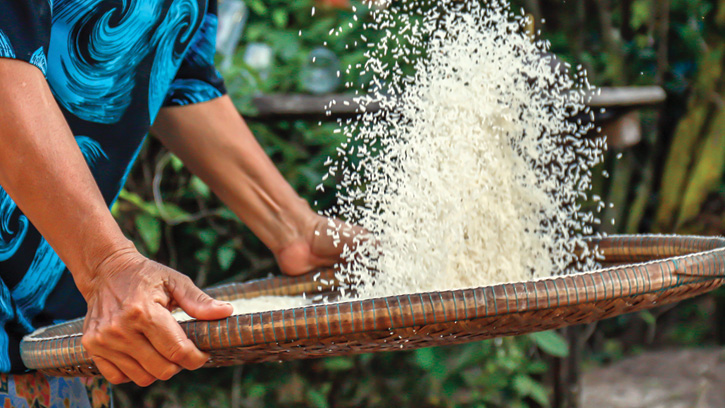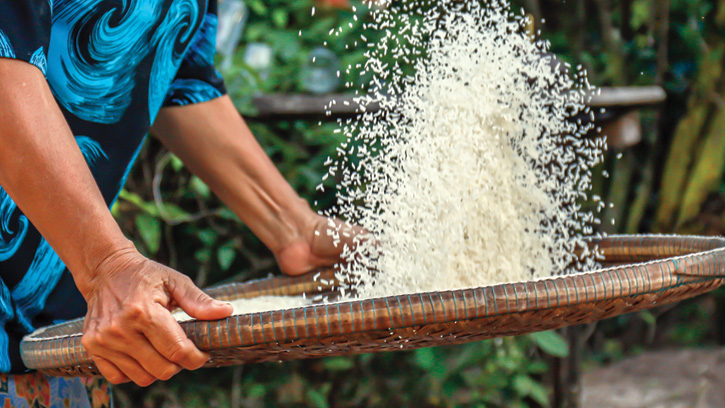Fortified Extruded Rice Fights Hidden Hunger
Food Security | INNOVATIONS
A clever approach to rice fortification uses extrusion technology to transform broken rice into fortified rice analogues that look, taste, and cook like regular rice. This affordable process has the potential to reduce micronutrient deficiencies wherever rice is a staple food—including Indonesia, where a pilot study showed it can reduce the prevalence of anemia in teenage girls.
Micronutrient deficiency, also known as “hidden hunger,” affects an estimated two billion people or about one in four people worldwide (von Grebmer et al. 2014). In Indonesia, it’s about one in two (IPB University 2022). The inability of many to afford fruits, vegetables, nuts, and animal-based foods has led to diets that lack diversity and key micronutrients, such as iron, iodine, folic acid, zinc, and vitamin A (IPB University 2022).
Food fortification (particularly when government mandated) is an effective strategy for reducing vitamin and mineral deficiencies in populations because it does not require consumers to change their behaviors. The ideal fortified food is regularly consumed by the population, has a low risk of excess consumption due to a predictable consumption pattern, and is relatively low in cost (FAO 1997).
With 97.7% of Indonesians consuming rice daily (Ministry of Health Indonesia 2015), rice was the perfect choice for the 2016 fortification pilot study conducted by the Food and Nutrition Society of Indonesia. In collaboration with the Better Rice Initiative Asia, the German Agency for International Cooperation, and nutritional ingredient manufacturer DSM, this fortified rice was tested on 108 Indonesian girls aged 14 to 18 with symptoms of anemia.
Indonesian food company PT Fits Mandiri produced the fortified extruded rice for the study using the hot extrusion method. The standard process begins with broken rice, which is ground into flour and blended with water and a micronutrient premix to form a dough. The dough is then extruded into fortified kernels that look like rice, of which 0.5%—2% are added to regular rice (DSM 2019). For this study, the micronutrient premix contained iron, zinc, thiamin, niacin, folic acid, vitamin B12, and vitamin A (targeting over 75% of the Recommended Dietary Allowance) with the fortified kernels blended at 2% (Hardinsyah et al. 2016).
One major benefit of extrusion-based rice fortification is that it uses broken rice, a lower grade rice that costs less. In Indonesia, from 2.6% to 46.6% of rice kernels are broken during the milling process, depending on the variety (Kobarsih and Indrasari 2021). The hot extrusion method also leads to a more robust product compared with dusting and coating methods, in which rinsing and excess cooking water often wash away micronutrients and taste and color issues are common (Steiger et al. 2014).
For the 15-week pilot study, the girls were given the extruded fortified rice at 450 grams per day for six days a week (Hardinsyah et al. 2016). At the study’s end, the results showed a significant increase in ferritin and folic acid levels in the test group compared with the control group and a decrease in the prevalence of anemia by 41.4% (Hardinsyah et al. 2016).
Although nutritional status improvements were not seen for all the vitamin and mineral fortifications, the study indicates the potential of extruded fortified rice to reduce micronutrient deficiencies in Indonesia, perhaps with adjustments to the types and amounts of micronutrients used. A more recent study highlights the potential of local cassava and tempeh flour to fortify extruded rice (Putri et al. 2021)—another innovative food science approach to fighting hidden hunger.
What Is FSRD?
IFT’s volunteer-led Food Science for Relief and Development Program under the International Division uses outreach, collaboration, and case studies to encourage the incorporation of food science and technology into food security initiatives. Learn more at info.ift.org/en/fsrd-21.


